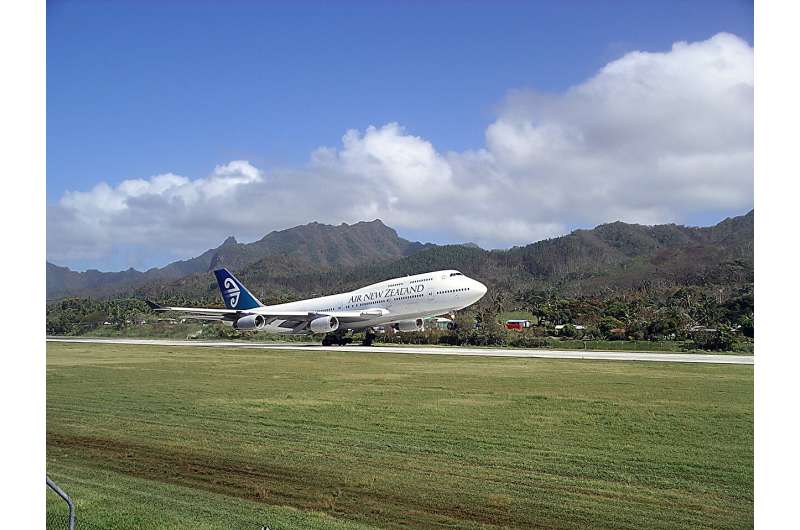This article has been reviewed according to Science X's editorial process and policies. Editors have highlighted the following attributes while ensuring the content's credibility:
fact-checked
trusted source
proofread
What key ingredients does Australia need to build its own sustainable aviation fuel industry?

A sustainable revolution is growing across the sun-drenched slopes of Australia's agricultural regions. Our future farmlands have the potential to do more than produce food. They could also power the bioeconomy, support our energy transition, buffer farm incomes and promote biodiversity.
Aviation accounts for about 2.5 percent of global carbon dioxide emissions. With air travel expected to double by 2050, emissions are set to grow quickly. Our Towards Net Zero Mission is paving the runway for Australia's very own sustainable aviation fuel (SAF) industry to help decarbonize aviation.
What is sustainable aviation fuel (SAF)?
SAF is jet fuel made from renewable sources as opposed to conventional fossil jet fuels. This can include biomass, which is material that comes from agricultural crops and waste, animal fats and vegetable oils. SAF drops into existing infrastructure and can achieve between 60 and 100 percent reduction in emissions compared to conventional jet fuels.
To help understand the key ingredients in Australia's SAF journey, we launched a SAF Roadmap in collaboration with Boeing. The roadmap identifies our opportunities to produce and scale a SAF industry.
Five key ingredients for a sustainable aviation fuel industry
Biomass with benefits
Australia will need to grow new crops and collect crop residues such as sugar cane pulp, to create enough biomass to fuel the industry. We will need to produce biomass in a way that adds value, by understanding the co-benefits and trade-offs of different feedstocks.
Treatment
These different feedstocks need to be collected and transported to a treatment center. There, impurities are removed leaving a clean raw material. We will need to grow feedstocks in strategic areas to efficiently group processing facilities. This will help reduce the costs associated with transport and infrastructure.
Green processing facilities
Hydrocarbons are the main components of fossil fuels like petrol and natural gas. We can also create hydrocarbon molecules (and therefore SAF) by processing biomass in certain ways. But these facilities must run on renewable energy to have the most impact on net emissions reduction.
Certification
For Australian-produced SAF to be sold in global markets and labeled as SAF, it must meet international standards. To ensure that all SAF meets these standards, Australia will need to develop certification processes including lifecycle greenhouse gas assessments.
Distribution
Once the final product is ready, it needs to be transported and stored. We will need to develop distribution and storage pathways with efficiency and resilience in mind.
Australia's sustainable aviation future
Building a new industry is complex. There are many areas of science involved, which need to be coordinated. It is an integrated, multi-scale challenge, but it is the sort of challenge we excel at. Australia also has a long and successful history of agriculture. This combination creates the opportunity for us to farm feedstocks and create a domestic SAF industry.
Our Towards Net Zero (TNZ) Mission is accelerating efforts to reduce industrial emissions in Australia's hardest-to-abate sectors, including aviation. Warren Flentje is TNZ Mission's Industrial Decarbonisation Lead. He said Australia already produces a huge amount of biomass for use in SAF in Europe.
"By developing our own SAF industry, we can create new opportunities like liquid fuel security and regional jobs, all while reducing the net emissions from one of our hardest to abate sectors," Warren said.
Currently, Australia imports 90 percent of its liquid fuels, including jet fuel. These long supply chains expose us to geopolitical changes and climate risks. Australia can help manage supply risks while boosting regional jobs by growing feedstocks and producing fuels here.
To do this, we will need to work with people in regional areas to grow crops, build infrastructure, and manage supply chains for SAF production. These jobs won't exist if we export feedstocks overseas without refining and making fuel locally.
Navigating the future of sustainable aviation fuel
SAF has two major challenges: high costs and feedstock availability. By informing long-term policy frameworks we can attract investment in the industry. This will help reduce costs and fund research and development into the commercialisation of new feedstocks. We have an opportunity to use existing crops and waste oils. But we also need to develop supply of non-food feedstocks to address cost and land use challenges. Here are some examples:
Algae
We can use fatty acids produced by algae to make SAF. Algae are promising because they have no food value, produce high yields and don't take up much land.
Leaf oils
Terpenes are a type of hydrocarbon that comes from the oil of plant leaves—mainly eucalyptus, pine and tea trees. Their molecules are a similar length to the hydrocarbons in conventional jet fuel. But each leaf only contains small amounts of oil so we would need massive amounts of leaves to process into SAF.
Power to liquids
Eventually, we will move to power-to-liquids (PtL). This involves making jet fuel using non-biological feedstocks, such as hydrogen and carbon dioxide, along with renewable energy sources. Our research into the Fischer-Tropsch (FT) process aims to produce a range of products from hydrogen and carbon dioxide. This includes FT wax, which can be stockpiled safely and upgraded into jet fuel during times of need.
As Australia looks down the runway towards our net zero targets, we need to reduce industrial emissions in a way that creates new social, environmental and regional benefits. SAF will play an important role in our ability to meet our net zero targets by 2050. It also provides an opportunity to build new jobs in our regional centers and bring security to Australia's jet fuel industry, while delivering co-benefits like biodiversity and income buffers for our farmers.


















